Study Guide Science 5th grade -Weather and Climate 2
Weather- the day to day changes of :
temperature, precipitation, wind and air pressure.
Climate- long term patterns over a period of time of an area. The average over many years. Climate changes very slowly.
3 Major Climate Zones
1. Tropical –warm and wet most of the year (equator)
2. Temperate (go through cycles of cold and snowy or hot and dry) in between areas
Temperate zones usually have four seasons (winter, spring, summer, fall)
3. Polar (cold and dry most of the year (North/South Poles)
Temperature – the measurement of the condition of the air. How warm or cool is the air?
Wind Direction – Which way is the wind blowing? Named for the direction from which it is blowing. IF the wind is blowing from the SW (Southwest) then the winds are considered SW winds.
Types of Precipitation – water that falls from clouds in either liquid or solid form.
1. Rain
2. Sleet
3. Hail
4. Snow
5. Freezing Rain (the atmosphere is warm but the temperature on the ground is freezing-so the rain freezes on contact)
Air Pressure – the weight of the air.
Cold air is heavy and wants to sink, therefore making the air feel heavy and creating
HIGH PRESSURE. (cold air is more dense so it drops)
The Weather is Cold and Dry when it is HIGH
Warm air is Light and wants to rise, therefore making the air feel Light and creating
LOW PRESSURE. (warm air is less dense so it floats or rises)
Warm and Wet Weather is What Low Pressure Gets
HIGH PRESSURE ALWAYS FLOWS INTO LOW PRESSURE. Cold air always wants to warm up. H L
Differences in Air Pressure/Temperature Cause Wind
Air moves from places with high pressure to places with low air pressure.
This creates wind (the uneven heating of air-some air is warmer than other air)
The greater the difference in air pressure between the two places- and the shorter the distance between them- the stronger the wind.
Cloud Chart
Cloud Type Weather and Location
Cirrus (Curl)  |
High clouds, clear skies, warm temperatures, no precipitation, formed from ice crystals, called thin, wispy or stringy |
Cumulus (Heap) |
Middle clouds, partly cloudy skies, mild temperatures, look like fluffy cotton balls possible precipitation (10-50%) |
Stratus |
Low clouds, looks like a flat blanket, arranged in layers, cloudy skies, usually gray in color, cool temperatures, good chance for precipitation (50% or higher) |
Cumulonimbus |
Storm clouds that form in all layers of the atmosphere, strong winds, heavy precipitation. Dark in color. Nimb- (means rain producing) |
Rain Shadow
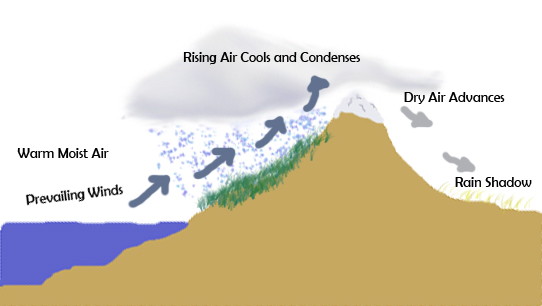
Mountain and Valley Breezes
Mountain Breeze-At night, the process is reversed. Mountain air cools rapidly at night and "falls" down slope, causing a wind going in the other direction.
Land and Sea Breezes (High Pressure goes to Low Pressure)
![]() Low Pressure High Pressure
Low Pressure High Pressure
Air is warm and light Air is cool and heavy
because the warm land is because the cool water is
heating up the air above it. cooling the air above it.
![]()

When you are on the beach, during the day the sun heats the land faster than the water and makes the air above it hot this air rises and pulls in air from the sea to replace it, this is a sea breeze.
![]() High Pressure Low Pressure
High Pressure Low Pressure
Air is cool and heavy Air is warm and light
because the cool land is because the warmer water is
cooling the air above it. heating up the air above it.

At night the land cools down and when it is colder than the sea (which remains almost the same temperature day and night) then hot air rises from the sea surface and it pulls in air form the land, this is a land breeze.
Jet Stream
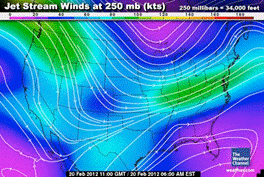
A tubular ribbon of high-speed winds, generally from the West and moving East and at a high altitude (height) of 20,000 to 40,000 feet
Air Mass
An air mass is a large body of air that has similar temperature and moisture properties throughout.
Air Masses can be warm/wet, warm/dry, cold/dry, cold/wet etc. depending on where it originated (or came from).
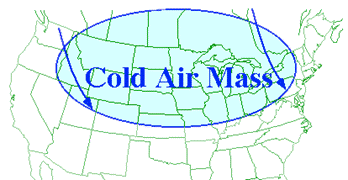
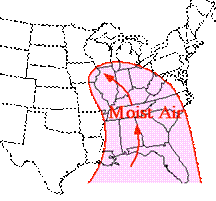
Polar Air Mass from Canada Maritime (Wet Mass from the Gulf of Mexico)
Fronts
The line between two chunks (masses) of cold and warm air.
Fronts are boundary lines where to air masses meet. Storms often occur at fronts.
Cold Front- Cold Air Replaces Warm Air
(shown by a blue line with triangles pointing to where the air is moving)
The warm air, which holds a lot of water vapor, gets pushed upward quickly.
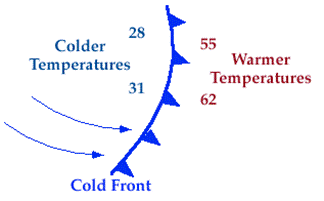
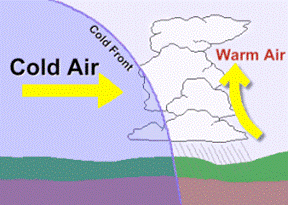
When a cold front passes through, temperatures can drop more than 15 degrees within the first hour. Also, usually causes heavy rains, sometimes with hail, thunder and lightning. This type of storm is often violent, but it ends quickly.
Warm Front- Warm Air replaces Cold Air
(Shown by solid red line with semicircles pointing towards the colder air and in the direction of movement.)
The warm, humid air eventually rises high enough for water droplets and clouds to form, and rain to fall.
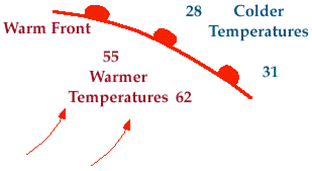
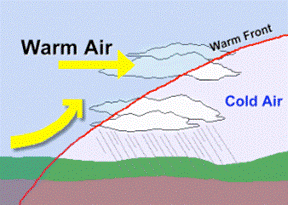
When a warm front passes through, the air becomes noticeably warmer and more humid than it was before. Precipitation will be steady rain and will last longer than a cold front.
Weather Instruments (Tools Meteorologists use to measure weather)
Name of Tool |
What it Measures |
Hygrometer |
the Humidity or moisture in the air (how much water vapor) |
Thermometer |
Temperature |
Anemometer |
Wind Speed (how many miles per hour) |
Rain Gauge |
Precipitation (Amount of Rainfall) |
Wind Vane (Weather Vane), Wind Sock |
Wind Direction (North, East, South, West) |
Barometer |
Measures air pressure (high or low) |
Doppler Radar |
Direction and speed of rain drops as radar energy bounces off them |
Weather Balloon |
A balloon sent into the atmosphere to take measurements of air pressure, temperature etc. in the layers of the atmosphere |
Source: http://teacherweb.com/ON/StMatthewTheEvangelistCatholicSchool/MrRudback/Study-Guide-for-measurement.docx
Web site to visit: http://teacherweb.com
Author of the text: not indicated on the source document of the above text
If you are the author of the text above and you not agree to share your knowledge for teaching, research, scholarship (for fair use as indicated in the United States copyrigh low) please send us an e-mail and we will remove your text quickly. Fair use is a limitation and exception to the exclusive right granted by copyright law to the author of a creative work. In United States copyright law, fair use is a doctrine that permits limited use of copyrighted material without acquiring permission from the rights holders. Examples of fair use include commentary, search engines, criticism, news reporting, research, teaching, library archiving and scholarship. It provides for the legal, unlicensed citation or incorporation of copyrighted material in another author's work under a four-factor balancing test. (source: http://en.wikipedia.org/wiki/Fair_use)
The information of medicine and health contained in the site are of a general nature and purpose which is purely informative and for this reason may not replace in any case, the council of a doctor or a qualified entity legally to the profession.
The following texts are the property of their respective authors and we thank them for giving us the opportunity to share for free to students, teachers and users of the Web their texts will used only for illustrative educational and scientific purposes only.
All the information in our site are given for nonprofit educational purposes
The information of medicine and health contained in the site are of a general nature and purpose which is purely informative and for this reason may not replace in any case, the council of a doctor or a qualified entity legally to the profession.
www.riassuntini.com